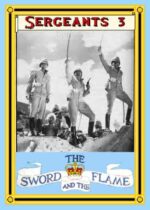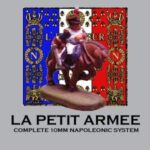Sam Mustafa Publishing LLC publisher of the Honour series of rulesets, including the Lasalle Napoleonic rules.
AurelianAurelian is a tabletop game of the Crisis of the Third Century. Can you hold the Roman empire together in the face of civil war, barbarian invasion, and war with Persia?
FreejumperFreejumper mixes role-playing, sci-fi and tabletop battles in a fun and social game about spaceship design, combat, smuggling, and adventures. Build your own ship, play with any number of friends using the ten adventures, or create your own.
LongstreetThe beautifully-illustrated full color 160-page book with all the basic and advanced rules, scenarios and grand campaign. The Longstreet book is a handy smaller (A5) page format with a sturdy double binding for regular use. Printed in the USA.
Maurice
RommelRommel is a tabletop game of great battles in the European and Mediterranean theatres of the Second World War.
The player takes the role of a general commanding an entire division, or elements of several divisions, or an entire corps or even an army. Units represent companies and battalions. Tens of thousands of men and machines clash for control of miles of territory. Make decisions about the application of air power, engineering, the use of reconnaissance, the commitment of mobile reserves, and many other things.
BlücherThe Hundred DaysWar To The Death
LasalleLasalle is the petit-tactical game of Napoleonic warfare. It comes with historical scenarios and an army-builder that allows players to create a huge variety of customized armies for different nations and theatres of the Napoleonic Wars. Lasalle is ideal for small tables and tournament play.
Might and ReasonMight and Reason is the grand-tactical game of 18th century warfare.
Haledon
New Jersey
07508
United States
Sergeants 3 publisher of wargaming rules.
About Us
"Why the name change?" ~ by Larry Brom
The new name for our rules publishing division, Sergeants 3, will certainly be no surprise to the many gamers who know me quite well. For others, let me clarify.
In 1939, my father took me to a movie theatre in downtown Chicago for the premier showing of "Gunga Din". The exploits of Sergeants Cutter, McChesney and Ballantine, and the Bhisti, Gunga Din, etched images in my young mind and soul that have stayed vividly with me to this very day. I still firmly believe that film is the finest movie ever made. Even today, when I view "Gunga Din" (which I do regularly), the sound of the pipes playing and the Highlanders singing "Bonnie Charlie" still manages to raise the hair on the back of my 75 year old neck. And for those of you who consider my game rules "too Hollywood" you are exactly right. And now you know why.
"Good job, Bugler".
"The Birth of Some Rules" ~ by Larry Brom
One of By Jingo!'s illustrious editors who shall remain anonymous has asked, nay insisted, that one of my first essays be a history of, and the motive for, writing The Sword And The Flame. I have reluctantly agreed to do this, but my better judgment gives me the sense that most gamers, like me, do not want to hear some lofty, pompous, "world-famous" rules author expound on the " soul-searching", "gut-wrenching" and "inner turmoil" associated with the creation of his true work of art. So, let me merely say that I wrote my first set of published rules because at that time colonial rules were almost non-existent and the one set I knew of did not suit me.
I became very interested in Colonial gaming in the early 1960's with the advent of Holgar Ericson's 25mm painted (not very well) SAE (South African Engineers) war game figures. I made the discovery of these "gems" in a toy store in NC when I went in to purchase some doll furniture for one of my daughter's birthday. Those amazing figures - resplendent in their orange boxes (about 16 or 17 infantry figures to a box) and costing about $2.50 per box, almost bowled me over. Strangely, this store in North Carolina had among their sets of mainly ACW troops, one box of British Colonials in scarlet tunics and white pith helmets, and 4 boxes of charging Zulu warriors. These five boxes were the start of this whole Colonial madness. (By the way, I did get the doll furniture too, for those of you who were wondering but, I can't recall the color or price!)
I now had the figures and the interest, but ahh, the rules.
I had been a subscriber to Jack Scruby's publications with many home grown rules and game concepts and in 1965 joined Doug Johnson's Colonial Society Bulletin (now Savage and Soldier) that offered additional colonial gaming ideas. To this point the only published set of gaming rules I had ever seen was a reprint of H.G.Wells' Little Wars circa 1913. Then, in the late '60's, I came across (whether in a magazine or a booklet) a set of Colonial Game Rules from England. I have no idea what they were titled but they were a well-crafted little set in the classic style of British game rules of that era. I had acquired more colonial figures by this time so I coerced my one gaming friend into having a go at colonial gaming. We eagerly played 4 or 5 games with this wonderful new rule set, having great fun but then realized that neither of us wanted to be the native force ! Where was the challenge ? Once the forces of the Empire were formed and ready and the Dervish or Zulus got in range, it was all over. Historic, but discouraging! No wonder no one played "colonials", no one was doing rules, and there weren't many figures available. Shortly thereafter, my friend moved out of the area and with no one to game with I concentrated on building more mainstream armies; ACW, Napoleonic and Franco-Prussian, and developing my own rules for each period.
It was now the early 1970's and more and more rule sets for miniature war gaming were available. Most of these were from Britain and a few from the U.S. (the ones I knew of). So I purchased a goodly number, played games with a few, and read all of them. Slowly, in my view, it became apparent that something was lacking . But what? Most of these rules were well crafted, offered some interesting mechanics (like "saving throws", which to this day still mystify me), introduced morale, some form of command control or influence, utilized masses of modifiers and myriads of other concepts to make table top games more "realistic".
Then came the revelation. I wasn't having any fun!! I was too busy with the game mechanics, thumbing through pages and cross referencing chart A.1 with C.2-e. Then and there I decided, no more. I would design my own rules for my own enjoyment. I would go back to my first love, British Colonials. I had small armies - all I needed were some rules and since I had been doing home grown versions for some time, I commenced.
All the rules I was aware of, and my own that I had written, were subjected to serious scrutiny based on what I thought I wanted to do with miniature painted military figures on a game table as a hobby and to have some fun. After some months, I settled on the five things I desired in a set of rules that in my opinion did not exist in the rules I knew of in the early '70's. Simply put, these factors were Enjoyment, Playability, Drama, Excitement and Historical Flavor.
Curiously, after I pinned my quest down to these issues and went back and scanned all the rules I was aware of, none of them made any reference in their Introductions or Designer Notes to these factors (and most of today's rule sets don't either). At that point, I determined I was out of the mainstream of miniature gaming and always would be. So, I could just design rules for myself using the above criteria, and relax and enjoy the hobby
Early in 1978, S. Craig Taylor contacted me (he was with Heritage Models in Dallas at that time) about the possibility of doing an introductory set of game rules for the Colonial era to be issued with miniature figure sets for the same period. After some more phone and letter communication, in June of 1978 I signed an original agreement and started on the rules; sometime between this date and the actual release of the rules in 1979, Taylor ended up with Yaquinto Games in Dallas.
Because these rules were designed 20 years ago, I would be hard pressed to share the exact reasoning and thought processes involved in the complete creation of the rules as they finally evolved. Other than always keeping my five main considerations regarding gaming rules uppermost in the development of the overall concept, I will highlight three issues I was determined to address with this, my first published rules attempt; 1) alternate movement (you move, I move) and firing (you fire, I fire), 2) excitement of hand-to-hand combat (most games didn't have it) and 3) measured move distances, i.e. (infantry move 6", cavalry 12", etc.)
I knew from the start there had to be Random Movement in some form or the other. Most games at that time did alternate movement. How wonderfully choreographed, while you are moving your units I leisurely watch every troop disposition and calmly plan every counter move I will make when it's my turn. No surprises, no hurried response from me and no excitement! I toyed with a number of techniques; How about an initiative roll (quite common now, but not in the '70's), high roll moves first ? Maybe not only high die moving first but actually moving that number of units? Make up "movement" cards by writing the name of each player's units on an individual card, shuffling them in a deck, turning them over, flipping the top card and moving that unit. This was the procedure I was going to use when one of my daughters asked, "Dad, instead of going to all that trouble, why don't you just use a deck of cards"? Now, I'm no fool, I know a brilliant idea when I hear it, and so my famous, "random move card innovation" was born! And it still exists today in many, many successful forms thanks to a young girl's common sense. The card deck also addressed and answered the random firing issue - same technique, same randomness. I was well on my way to the rules concept I wanted.
I have always believed that the most exciting moments in any wargame are, and should be, the hand-to-hand combats. These are the culminations of all our planning, maneuvering and evolutions on the table top. To close with the enemy, drive him from his positions and exert our moral superiority over his forces and win the day. The dullest close-in-combats I have ever participated in, or seen, in the past (and even today), are those where wonderfully painted figures or units with colors flapping in the breeze close with an enemy with shouts and screams, bayonets flashing, then comes a halt to resolve the combat phase which usually goes something like this; count the number of figures or units, consult the charts for point values, calculate a dozen plus or minus modifiers, eventually come up with a number value, then each player rolls one multi-sided die and a high total number wins the melee' with one die roll!! Where is the suspense, where is the drama? There is none! Any game system I have ever designed settles close-combat ultimately by pitting figure against figure or stand against stand and opposing players roll six-sided dice with simple modifiers and the high total wins; this is for each pair of opponents. A lot of die rolling, I know, but this is a contrived game mechanic to accomplish one thing - excitement. In our hobby of gaming with miniature figures we are pitting our skill, concepts, knowledge and luck against an opponent in simulated combat on a table top. My theory of eye-ball to eye-ball confrontation by rolling as many dice as we can for individual combat resolution is the closest we civilized beings will ever come to actually crossing swords, bayonets or tomahawks. And talk about suspense, drama and excitement , at any convention , anywhere, if all of a sudden one game table erupts in loud cheers, groans and finally exultation, the high probability is that a melee matching man for man or stand for stand was just culminated. I know because that's what happens at my games and I will guarantee it !
Measured move distances are probably the strangest aspect of gaming rules that we have ever embraced. The idea that two armies or forces on any given table top would always all move at exact precise distances is, and always has been, incredible to me. I won't even address historic justification that this is a fantasy, but merely put the issue into the framework of wargaming. Of course, control freaks love measured distances. It is absolutely wonderful during a game to have enemy cavalry on your flank and by firing a battery at them (you had to measure the range, of course) you know they are 48" away. Since they are cavalry in line and move 12", you smugly know that you have 4 turns to prepare for their attempt at outflanking you. What an exciting challenge! No risk, no drama, and it's a piece of cake. But not for me! I did, and still do, favor some form of random move distances in all the games I design and play to offset this artificial concept.
Once I had incorporated these major issues into the rules system I was formulating, I was close to completing the first draft of the rules. What remained was the tedious detail, formatting, and integration of all the charts and other necessary minutiae that encompass the creation of a workable, playable rules system that reflects a designers vision of battle in a particular historical period. Through all these phases of fashioning the rules framework are the endless and repetitive play-tests, play-tests, and more play-tests. This is the key to a workable, playable set of rules. And the correct group of play-testers is essential. I was extremely fortunate to have the Jackson, MS. War Game Society at my beck and call (ha!) This group was the most stubborn, opinionated, argumentative gathering of gamers the world has ever known and could tear apart any set of rules in two turns or less but, if you could hang in there with them, their revisions and suggestions were almost magic.
The first rough manuscript was submitted to the rules editor July 3, 1978 for his review. After lengthy dialogues between us, a 2nd draft was submitted August 28, 1978. The 3rd, and final, rules draft was sent to Yaquinto on January 22nd, (shades of Ishlandwana) 1979. Sometime that summer the rules were produced and released to the gaming community.
If you have stayed with me through all of this, maybe you have a feeling of how and why I created The Sword and the Flame rules. I have always been very pleased with the mostly positive response to them and appreciative of all of you stalwart gamers who were willing to take a chance on a rogue set of rules and played, endorsed and enjoyed them through the years. You realize, of course, that if you read this article, play Colonial games and embrace a slightly different approach to gaming, you are a renegade, an outlaw and outside the "main stream" of miniature war gaming. But have courage, my comrades, we are a force to be reckoned with and our numbers are growing. So, roll the dice, randomly move and enjoy yourselves, the game has just begun.
c/o Lori Brom
2527 S. Carrollton Avenue
New Orleans
LA 70118-3013
Siege Works Studios are an Australian games company which produce our own rules and miniatures. We make miniatures in 15mm and 20mm.
7 Sir Tristram Court
Jimboomba, Q'ld
Australia
4280
Miniature Flags for Historical Miniature Gamers and Collectors. Complete 10mm Game System and Products for the Napoleonic Wars (La Petite Armée) and American Civil War (LPA:ACW, Limited Edition).
If you have been thinking of getting into war gaming the Napoleonic period, you’ve probably been overwhelmed by the questions, choices, and amount of information and advice out there. What scale of figures? What level of command when choosing the rules, and then which of the dozens of rules available do you use? How and where do I get the terrain? Will I be able to find an opponent who has made the same decisions I have?
The decisions may seem endless and daunting to a new gamer so I have created the LPA Complete 10mm Napoleonic System. It is just what it claims to be – COMPLETE! – a ready to play game right out of the box. It’s not like some “complete” starter sets that give you a couple of bags of unpainted miniatures a set of rules and a couple of paper buildings. Each LPA Complete 10mm Napoleonic System comes with two painted 10mm armies, one French and your choice of a British, Russian, Prussian, or Austrian army as an opponent – over two-hundred figures and guns already mounted on flocked, magnetic movement stands and metal magnetic brigade stands with the appropriate national flag. You also get all the terrain you need to set up an attractive 3’x2’ battlefield including three 2’x1’ battleboards, six hills, eight buildings, twenty trees, four fields, four stone wall sections, four sections of hedges, one stone bridge, and material for roads and rivers – and everything is already painted and/or assembled. You get a set of rules, La Petite Armée, with reference cards, markers, casualty caps, and markers – even dice and rulers. And everything comes packed complete in a handy, portable box for easy transport. And you don’t have to worry if someone else has the same scale figures or plays the same rules. Since each game is complete, all you need is an opponent ready to play. Games with the basic set, representing a Corps of 15,000 plus men on each side, can be played to completion in 2-3 hours.
Many of my customers have purchased just the basic game system and fought dozens of enjoyable battles over the years without every feeling the need to expand what they have. Others have added additional games, armies, terrain, etc, to fight the size battles they are looking for. I myself have the equivalent of four games worth of terrain and over 2300 figures in my set. It is up to you. If any of these apply to you, then welcome to the world of Le Petit Armée Complete 10mm Napoleonic System. This system is designed to provide you with one-stop shopping when it comes to your Napoleonic gaming needs. LPA is based upon a set of rules of the same name, and every item you need to play using those rules can be obtained using this system.
And LPA is not just for gamers new to the Napoleonic period. I myself have been gaming for over thirty years and many of my customers are also experienced players who have been attracted by the smaller scale, easy to learn and play rules, and overall look of the LPA system.
Las Cruces
NM
88001
United Sates
Spectre Miniatures takes you to the cutting edge of modern warfare. Spectre: Operations introduces a world of action and intrigue, where special forces, intelligence agents and military contractors are on the front line, carrying out covert operations against a multitude of adversaries; including enemy nations, unstable regimes, ruthless warlords, insurgents, mercenaries and paramilitary groups.
Special forces, intelligence agents and military contractors are on the front line carrying out secret missions against a multitude of enemies including ruthless warlords, insurgents and paramilitary groups.
Become part of an immersive, world-spanning story through a comprehensive range of tabletop miniatures, wargames terrain and unique rules set.
PO Box 10506
Nottingham
NG8 9NN
Strikenet Games - Military Theme Board Games, Military Theme Card Games, Strategy Games.
Panzer Miniatures Rules: A Tactical Game of Armored CombatPanzer PaK 1: East Front OrganizationsPanzer PaK 2: Kursk Campaign GuidePanzer PaK 3: Normandy to BerlinPanzer PaK 4: Lend Lease ForcesPanzer PaK 5: British Drive to the RhinePanzer PaK 6: France 1940
MBT 2nd EditionMBT: 4CMBGMBT: BAORMBT: FRG
Iron and Oak
The Kaisers PiratesKaiser's Pirates: Expansion Pack
PO Box 7021
Ellicott City
MD 21042
Studio Tomahawk was born from the meeting of two enthusiasts whose passion for history, figurines and games resulted in creating a publishing house.
Studio Tomahawk first ambition is to offer miniature games that are as innovative as they are original where the pleasure of the player is the main consideration.
In addition to their own designs, the Studio team also translated games they loved from other publishers including Osprey Publishing with Frostgrave and Dracula’s America.
Whether in the forests of Canada, on the battlefields of the dark ages or in the heart of Africa, the horizons of Studio Tomahawk's games are vast, even… limitless!




